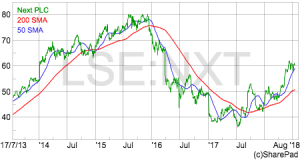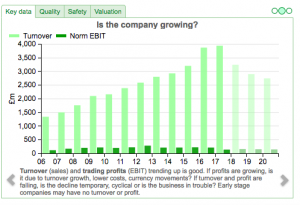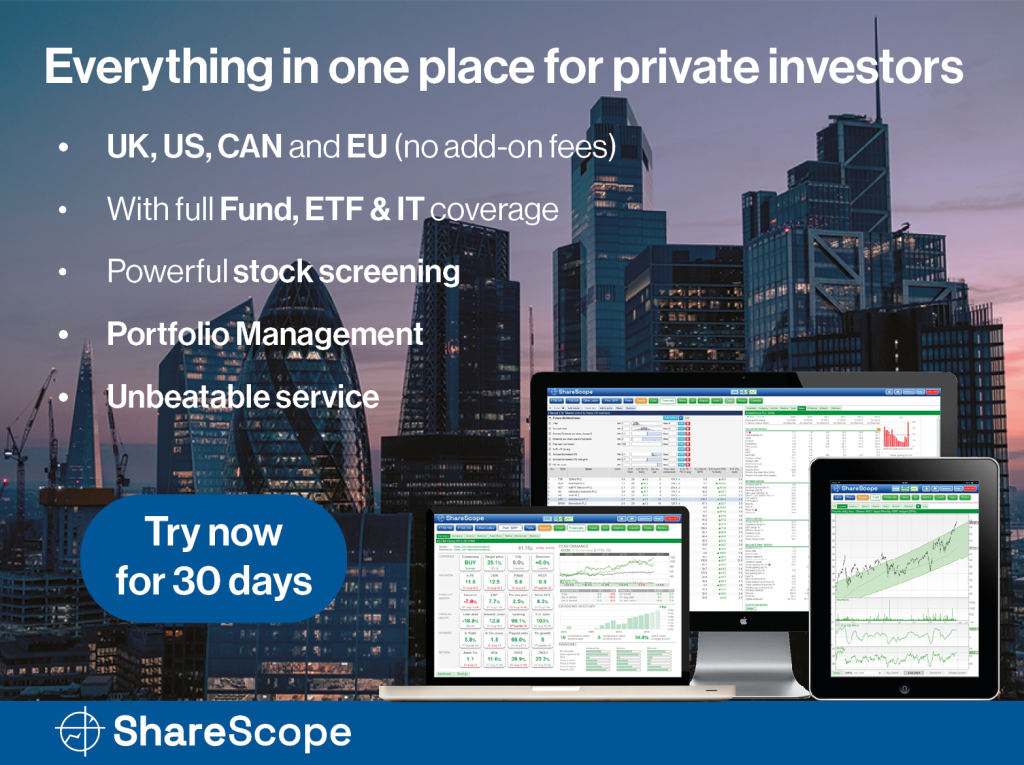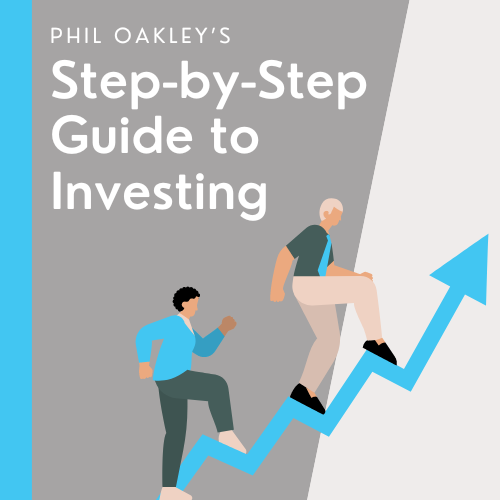Being able to analyse international shares — at no extra cost! — is a wonderful feature of SharePad. And finding overseas shares within SharePad is easy, too. Simply click on Other Lists within the main toolbar… …and take your pick from the various US and European indices available. I have chosen the top 500 US […]
Category: Company analysis
Screening For My Next Long-Term Winner: Games Workshop
Could now be the time to return to dynamic growth shares? Wonder-stocks such as Fever-Tree, Boohoo.com and Keywords Studios are all well below their highs of 2018… …and I wonder whether the widespread selling has created a super-growth bargain somewhere in the market! Let’s employ SharePad to find out. I bought the shares at £8 […]
Starting with the big picture
Richard starts his analysis of fast growing online beach holiday retailer On The Beach with new SharePad views designed to give him the big picture at a glance. Before I start dreaming about holidays, some humble pie. A few weeks ago I ridiculed the idea of using more than three SharePad windows by suggesting they […]
Magic Formula stocks for 2019 & 2018 performance
Back in 2016 we began testing and tracking three model portfolios based on Joel Greenblatt’s magic formula approach (click here to read more about this) and last year we added a forth model (click here to read this article). Regular readers will know how these portfolios are put together. Here’s a quick recap for the […]
Screening For My Next Long-Term Winner: Plus500
Before I start looking at Plus500 (LSE: PLUS), I have some good news…. …you can now employ my SharePad screening criteria with just a few clicks! The process involves SharePad’s amazing Filter library. This facility gives you complete access to numerous pre-defined filters that have been used within various SharePad articles. Just follow these instructions […]
Assessing whether profit is real
On the face of it Ricardo is a great company, but in recent years its earnings have deviated a long way from the cold hard cash that has flowed into the company. That may be changing. Though I don’t normally pay much attention to share prices, a 40% slump in the price of Ricardo values […]
How I build and manage my share portfolio
The key thing to stress at the beginning and, as many of you will already be well aware, there are many ways to become a good investor. There are many different techniques, many different styles and strategies from fundamental analysis, technical analysis to even astrology and Biorhythms. It sounds like a cliché but the best […]
Screening For My Next Long-Term Winner: Somero Enterprises
How did your portfolio fare during 2018? If you managed to side-step the market falls, very well done. For the rest of us — including me — I guess we can only cross our fingers and hope the FTSE performs a lot better during 2019! Still, with share prices in the doldrums and many investors […]
A SharePad for every occasion
Richard takes a break from company analysis and reveals a new layout for news, and reflects on some of the other tweeks he has used this year to make SharePad even easier to use. Season’s greetings! As the New Year approaches even my enthusiasm for digging into financials wanes and I indulge myself – and not […]
Two good companies, but which is better?
Richard takes a first look at Softcat, and he likes what he sees, even in comparison to rival Computacenter, another fine business. Both companies make good money distributing IT, but in Softcat he may have spotted a company with a growth culture. I wrote favourably about Computacenter in October, so I have two good reasons […]
A Special SharePad Investigation: Patisserie Valerie
Before I go any further, let me just state that I am not here to say “I told you so”. But whenever I have lost money on a share, I have always found going back to see where I went wrong to be very instructive. In fact, trying to spot the warning signs from any […]
Screening For My Next Long-Term Winner: Mattioli Woods
Many years ago, one of my favourite sources for investment ideas was the Financial Times. However, the FT’s articles did not interest me, and nor did the Lex column. Instead, I studied a small table that was tucked away on those pages that listed every share price. You see, this table named the shares that […]
Searching SharePad for something special
Richard Beddard investigates DotDigital in SharePad. The data indicates it has been very prosperous since it floated on the London Stock Exchange in 2011. A surge in investment suggests it intends to keep things that way. The starting point for many of the ideas I discover in SharePad is a basic four stage process that […]
Screening For My Next Long-Term Winner: Warpaint London
I am always looking for shares that can double, triple, quadruple or more during the years ahead. And one good way of finding such great investments is to study shares that have, well, already doubled, tripled, quadrupled or more. Take Fever-Tree (LSE: FEVR). This tonic-water specialist has rewarded savvy investors handsomely since the firm floated […]
What really makes a great business?
To identify great businesses we must go beyond the numbers and understand what causes them. In this article I revisit 4Imprint, an investment I should have made in 2013, and a business probably still worthy of investment today. Back in May 2013 I wrote excitedly about a company selling promotional products to US companies. 4Imprint’s […]
Filtering new issues
New issues have a reputation for delivering poor investment returns. In this article we filter SharePad for companies that may be more seasoned than they look. In my last article, I filtered SharePad for the firms that had been listed longest on the London Stock Exchange. Statistically speaking, the longer an investment has been listed […]
The old ones are the good ones
Exciting news: Aston Martin is readying itself to float on the stock market. Investors should think twice though, before buying the shares. Typically, it is the most seasoned firms that make the best investments. This is how you can find them. The Aston Martin story has many of the hallmarks of a big flotation. The […]
Building a base filter
To demonstrate how to filter in SharePad, we’ll build a base filter that filters out the shares we are least likely to be interested in. Our criteria will be personal, but the filtering technique can be applied to almost any investment style. Establishing your sweet spot To exclude shares we don’t want, we must decide […]
The perils of filtering stocks
This is the second article in the series “From ideas to investments” in which I look at the process of finding and evaluating investment ideas. Fishing for stocks using filtering, or stock screening, is a quick way to create a shortlist of shares that are likely to perform well – but only if we buy […]
How the stock market actually works
Today’s article is the first in a new series called ‘From ideas to investments’ which takes an in-depth look at how to generate investment ideas from fundamental data and develop those ideas into profitable investments. We’ll be looking at the benefits and pitfalls of stock screening and subsequent steps in developing a unique style incorporating […]
Next – A closer look at its online business

For many years Next has been a very profitable retailer of clothes and homewares. Like most of its peers it has had to face up to the changing world of shopping that has led more people to buy stuff over the internet instead of from shops on the high streets or in retail parks. Profits […]
Avoiding bad shares is just as important as picking good ones

If you’ve been investing in individual shares for a while then you’ve probably gone through the experience of losing some money on one or more of them. It’s a horrible feeling that happens to the best investors. You’d rather it hadn’t happened but the lessons you can learn from it can be invaluable in making […]
First steps to an inheritance tax-exempt portfolio
Investing in AIM-listed shares can help you reduce inheritance tax but you have to be picky. Not all shares qualify, and they must be good investments too. As usual, SharePad can help narrow down the field. What is an IHT-exempt portfolio? People with large estates can reduce the inheritance tax bill when they die by […]
Buying quality on its own is no guarantee of success

There are many different ways to make money from the stock market. Over the last few years, one of the most popular and discussed strategies has been about buying the shares of high quality businesses or quality investing. Warren Buffett has long been a cheerleader for long-term investing in quality companies. In the UK, the […]
A new issue that is already a winner
Looking through the prisms of profitability, debt, cash flow, strategy and valuation, Strix may be an exception to the rule that new issues make bad investments. Finance professor Elroy Dimson and his colleagues made a startling find when they studied the long term returns of UK Initial Public Offerings between 1980 and 2014. The longer […]
AGMs – If in doubt, ask
Most companies will answer questions from shareholders and potential shareholders. At Annual General Meetings shareholders have a right to ask questions and get answers. A large proportion of listed companies report full-year results in late winter and spring because their financial year-ends coincide with the end of the calendar year in December. As surely as […]
Should investors avoid low margin companies?
Highly profitable companies can make outstanding long-term investments. Arguably, the best way to measure a company’s profitability is to compare its profits with the amount of money invested to make them. This is known as the return on investment or return on capital employed (ROCE). One person’s definition of a highly profitable business will differ […]
Putting performance in perspective
To get a grip on where a company is going you have to understand where it has come from. Fortunately, that doesn’t mean reading every annual report. Usually, it’s not enough to read the latest annual report. To understand a firm’s business model and strategy, how it makes money, how it plans to make more, […]
Working out what could go wrong with a share
Investors pin their hopes on what could go right. The great product. The winning strategy. The growing market. The new technology. These may be good reasons to own a share, but only if you have also considered what could go wrong. In my last article I left you on a cliff-hanger. I described power adapter […]
Checking out a company’s cash conversion
A couple of weeks ago I wrote about the issues investors faced in working out a company’s true profits. In many cases, the ways in which companies calculate their so-called adjusted profits are becoming increasingly absurd. Investors are frequently asked to ignore certain real costs so that profits are as big as possible. The harsh […]
Decrypting a company’s business model and strategy
While it’s comforting to know a business has enjoyed success, long-term investors must also form an opinion on its prospects if we’re to hold the shares through thick and thin. In How to read an annual report, I identified the sections of a typical annual report that explain how a company has made money, how […]
Can you trust a company’s profits?
This article is more suited to experienced investors. Profits are all important when it comes to investing in companies. To make money over the long haul it usually helps to invest in a company that is growing its profits. The more profitable a company is, the more valuable its shares tend to be. However, profits […]
How to read an annual report
Rule number one in long-term investing is to understand how the businesses you expect to profit from will make money – otherwise, how can you be confident they will? Annual reports are the most complete source of public information on how businesses make money, and how they intend to make more money. Investors who read […]
A smarter way to use analysts’ EPS forecasts
Should investors pay much attention to analysts’ profit forecasts? There is a school of thought that suggests that they should not. Detractors say that forecasts are nothing more than educated guesswork and that analysts are very bad at predicting changes such as profit warnings or recessions. In many cases, forecasts are merely the extrapolation of […]
The Terry Smith algorithm
In this article I’ve attempted to find Fundsmith-like companies using SharePad. The results are mixed but there’s a lot to be learned from the experiment. A letter from Terry If like me you hold units in Fundsmith, last month you will have received a letter from the fund’s celebrated manager Terry Smith. In publishing an […]
A checklist for busy investors
There are many full time private investors out there but for others investing is a hobby or something that they fit around their day to day activities. If you don’t have a lot of time on your hands one of the toughest tasks you will have is narrowing down the list of potential investments on […]
Using SharePad’s “Live” tables in your own spreadsheets
Maybe you already download tables of data from SharePad by clicking on the sharing button in SharePad’s blue Table view, but this data is dead. It doesn’t change in your spreadsheet if it changes in SharePad. Now there is a new option: Export “Live” Table. This allows you to incorporate data into spreadsheets that updates […]
A better way to track changes in company performance
It doesn’t take too much time to get a feel for how well a company is doing. Most people do this by looking at percentage changes in key numbers – such as turnover and profit – from one period to the next. They may also look at key ratios such as profit margins or return […]
Buy and build
If you take a look at Diploma through the lens of SharePad’s summary page (under the green ‘Financials’ tab), you will find it shares many qualities of a good business. It has raised the dividend every year since 1999, a significant period in the company’s history as we shall see. It has grown turnover, profit, […]
Settings for the big picture
Happy New Year! I’ve started mine by tidying up my many desktops: my physical desk, my laptop’s desktop, and SharePad. I did so much experimenting with SharePad in 2017, I’ve overwhelmed the lists of settings. Settings are how we make SharePad our own. They are where we save list and chart configurations we use repeatedly, […]
Two charts to unlock a company’s finances
By way of introducing two charts I’m routinely using to suss out how companies are financed – the twin pillars of debt and equity – I need to return briefly to my last article on hire firms. In the main, tool and plant hire firms serve the construction industry which is notable for its instability. If […]
Is the current ratio an outdated measure of company safety?
One of the most commonly cited measures of a company’s financial strength is something known as the current ratio. It is a measure of liquidity and compares a company’s current assets – defined as assets that can be turned into cash within one year – with its current liabilities (those which have to be paid […]
Income Opportunities From Dividends
In the last of his Investors Chronicle articles, Phil looks at companies reinstating dividends or starting to pay them for the 1st time. Read pdf article
How to steer clear of dividend traps
First published in Investors Chronicle, Phil explains how to avoid the shares that might let you down. Read pdf article
Finding safe high-yielding shares
First published in Investors Chronicle, Phil explains how to identify which high-yielding shares are most likely to maintain or grow their dividends. Read pdf article
Finding companies that speak your language
Finding companies that speak your language It’s a commonly held view that the only bits of financial reports worth paying attention to are the numbers at the back – in the profit loss account and balance sheet for example. For investors alive to potential shenanigans, the audited numbers get us close to the unalloyed truth […]
How much is a company worth? A look at different ways to value shares
Two weeks ago I wrote about how to try and value companies that aren’t making a profit. This week I’m going back to basics for more inexperienced investors. Although I’m sure there will be some reminders here for regular readers. For many successful investors, the price they pay for a share of a company is […]
How to value loss-making companies
One of the questions I am frequently asked is: “How do I value loss-making companies?”. The short answer is that it can be really quite difficult. It is so much easier to try and value profitable businesses with an established financial history. However, the value of any business is based on how much money it […]
How I choose my next share using filters and charts
After many years of investment I still feel a sense of anticipation when I examine lists of shares looking for new opportunities. It’s like opening a map to find new places to visit, or a menu at a restaurant that serves everything. There are other ways to generate investment ideas, but in my experience they’re […]
Hunting in the minefield of cheap shares
Most people like a bargain. Bargain hunting on the stock market has long been a popular pastime or even a full time occupation for investors. There’s no shortage of books, articles and advice that tell investors to pursue a ‘cheap is best’ strategy if they want to get rich. Yet in most cases there is […]
The case for dividend investing in dangerous markets
I am finding investing more than just a little bit frustrating these days. The reason for this is that I am struggling to find shares that I am comfortable owning for the long haul. To put it simply, I think my favoured high quality businesses are overpriced whilst the valuations on many so called growth […]
Making sense of highly priced shares
In my 20 years of investing I am finding the current stock market conditions the most challenging I have ever encountered. My investing career started during the early stages of the TMT (technology, media and telecoms) boom. The case for investing in these sectors was based on a belief in transformational business models and the […]
The case for enterprise valuations
A couple of weeks ago I wrote about the subject of PE ratios (click here to read the article) and the ins and outs of using them to value companies. One of the main drawbacks of PE ratios – and any valuation using a share price – is that it can be distorted by the […]
PE ratios and how to use them
PE ratios and how to use them Price to earnings (PE) ratios are the most commonly used method of weighing up the value of a company and its shares. They are calculated using the following simple formula: PE ratio = Share price/Earnings per share (EPS) PEs are popular with investors because of their perceived simplicity […]
Looking beyond free cash flow
Ask me about the kind of financial characteristics I like to see in a potential investment and the first two I will usually cite are as follows: A high and sustainable return on capital employed (ROCE). Ideally I am looking for companies where ROCE adjusted for rented assets (leases) is more than 15%. Conversion of […]
Analysing the stocks in a filter
Running filters or screens is a popular way of finding shares to invest in. Whilst screening can be very powerful it is important to recognise that blindly buying shares which meet a set of financial criteria is rarely a route to success. Good investors use screening as a way of concentrating their research efforts. SharePad […]
Why depreciation matters and EBITDA doesn’t
When it comes to weighing up asset-intensive sectors, depreciation matters. It is a real cost. This does not stop people ignoring it and touting the merits of companies based on their EBITDA. Investors ignore the significance of depreciation at their peril and should be suspicious of companies that talk about EBITDA too much. To get […]
The end of “hidden debts”
Accounting is a dry subject but a very important one. I perfectly understand why private investors’ eyes glaze over at the mere mention of the topic. That said, I am a firm believer that when it comes to this subject a little knowledge can go a long way and can help you make better investment […]
How to avoid value traps
In this instalment, Phil explains how to spot value traps and finds some cheap shares that might bounce back. Read the article
Free cash flow: what it is and how to use it
In this week’s Investors Chronicle, Phil explains how to use free cash flow to your advantage. Read the article
Weighing up investment trusts
Many private investors like to build a portfolio of individual shares in order to grow the value of their savings as well as trying to beat the market as a whole. But some also like to complement their portfolios by owning investment funds. One of the best and easiest ways to do this is to […]
Riding a retail roll out
Note: This in an advanced article best suited to more experienced and confident investors. One of the most profitable investing strategies can be to buy the shares of rapidly expanding retail companies – when a company sets out a plan to open lots of new stores over a period of time. This is affectionately known […]
Paying up for quality shares – how much is too much?
“It’s far better to buy a wonderful company at a fair price than a fair company at a wonderful price.” – Warren Buffett “The desirability of a business with outstanding economic characteristics can be ruined by the price you pay for it. The opposite is not true.” – Charlie Munger The quote from Warren Buffett above is often cited […]


